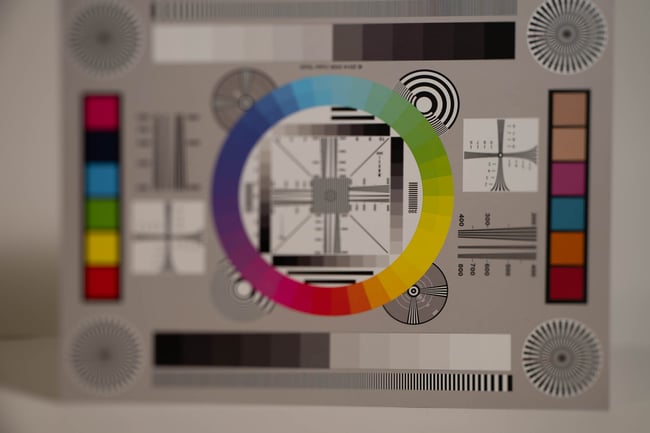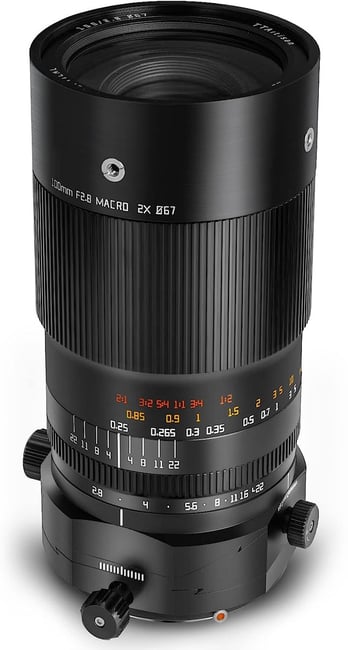The world of 100mm macro lenses a crowded one. From name-brand to third party options, there are dozens of options for all budgets and requirements. Yet among that crowd, the TTArtisan 100mm f/2.8 ultra-macro tilt-shift stands out thanks to the wide array of features packed into the lens, including 2:1 macro capabilities, tilt and shift functionality, and even cold-shoe mounts built into the lens. Yet it only costs $389. Do all these features add up to a compelling package?
Design and Features
The TTArtisan 100mm f/2.8 Macro 2:1 Tilt-Shift lens is currently made for Nikon Z, Sony E, Canon RF, Fuji X, L Mount, and Micro Four Thirds. However, at the time I’m publishing this review, it is sold out and hard to find in some mounts, especially L Mount and Micro Four Thirds.
In terms of the lens’s construction, it’s a pretty heft lens. Weighing in at around 1.75 pounds (800 grams), the all-metal construction makes for a formidable package. There is virtually no taper to the lens, either, so it needs considerable space in your bag. Roughly the middle third of the lens is taken up by a large, well-knurled focus ring, with markings for the macro ratio and the ft/m distance.
The rear third of the lens includes a clicky aperture ring, as well as the tilt/shift and rotation mechanisms. Near the front of the lens are a few small holes that allow for the attachment of a cold-shoe mount, useful for attaching lighting accessories for close-up photography.
On the copy I tested, both the aperture and manual focus rings were quite heavy to turn. While it’s unclear if they’ll break in over time, right out of the box, they are among the most strongly-dampened rings I’ve ever used. On one hand, that can make for very precise operation, but it also gets annoying if you need to quickly rack focus from macro distances to infinity.
The lens is strangely challenging to mount and dismount from your camera considering the large focus ring, aperture ring, and tilt-shift knobs. Add that to the highly dampened focusing ring, and I wouldn’t consider this lens seamless to use, ergonomically. I’d put it like this – you need to operate the lens deliberately, especially if you’re going to use the tilt or shift options.
Tilt-Shift Functionality
While there have been other lenses that offered both tilt/shift and macro functionality in one package, like the PC-E Nikon 85mm f/2.8D, the TTArtisan 100mm fully commits to both aspects. It features a whopping 2:1 maximum magnification, allowing the subject to appear 2x larger than life on the sensor – compared to the 1/2 life-size magnification of the Nikon PC-E 85mm tilt-shift lens. The TTArtisan 100mm f/2.8 also has the full suite of tilt, shift, and rotational functions.
Shift functionality in a macro lens is an often necessary function. Shift movements are more useful with with wider lenses, enabling the correction of things like vertical lines in architectural or forest photography. That isn’t very common in close-up or macro photography, but if you’re planning to use this lens for photos at normal distances, it could be more useful. The lens allows for 6mm of shift.
Tilt, on the other hand, is definitely useful for macro photography. Tilt functionality allows you to tilt the plane of focus relative to your sensor. Basically, this lets you capture more of a subject in focus, without having to stack your shots or stop down, assuming the subject is at an angle relative to your sensor. The lens allows for 8 degrees of tilt.


Lastly, since both tilt and shift can only be performed along one axis, the rotation functionality lets you rotate the lens around the sensor to line up those functions with the subject as required. This is a very useful feature not found on all tilt-shift lenses.
Optical Performance
For such an inexpensive lens, with such a complex set of optics and features, I was pleasantly surprised by the optical quality. At 2:1, 1:1, and macro distances in general, the lens is quite sharp, with the focus accuracy really being the limiting factor. Central sharpness does improve when stopping down to f/5.6 through around f/11, but this is a minor improvement on already good performance in the center.
The corners are good wide open, and they improve more when stopped down. For optimal sharpness, I’d really say the lens is best at f/5.6 or f/8. When shifted or tilted, corners are just OK wide open, although this is a challenging scenario, as the image circle is being pushed to its limits. Stopping down definitely helps here, and consider using f/8 through f/11 if you are employing extensive tilts or shifts. (For macro photography, you will often be at narrow apertures like f/11 and smaller anyway.)
Beyond sharpness, the longitudinal chromatic aberration performance of the lens is quite good. There’s no real visible color fringing in out-of-focus areas, even on high contrast subjects. This is huge for many macro subjects, including things like product photos, where some lenses will exhibit painful levels of background color fringes.

Flare performance and resistance on the TTArtisan 100mm f/2.8 Tilt-Shift is unfortunately a bit weaker. When focused at a distance, I noticed that even pointing the lens generally in the direction of the light could cause veiling flare that robbed some sharpness. Meanwhile, at high macro magnifications, some bloom can come up off of specular highlights. That isn’t really a surprise for such a complex lens at a $389 price point, but it would have been nice to have better anti-glare coatings on the lens.
One positive is the low level of distortion and vignetting on this lens. Even at f/2.8, vignetting was well controlled in my experience. Since I only field-tested this lens, I don’t have exact distortion figures, but I never observed it in any photos, either at macro or field distances. For a tilt-shift lens, that’s important – there is no easy way to correct distortion after the fact if you employed tilting or shifting to a photo.
Compared to other macro lenses, even third-party options, this lens is very competitive based on price. It is, however, a fully-manual lens, so you’ll need to get comfortable with focusing manually and setting the aperture via the ring on the lens. You’ll also want to understand the “bellows factor” effect, where the effective aperture of a lens narrows as you focus more closely.
In absolute terms, however, the TTArtisan 100mm f/2.8 has somewhat less sharpness than most macro lenses I’ve tested. It’s still plenty for typical macro subjects (when you wouldn’t be at f/2.8 anyway most of the time anyway), but for photography at a distance, I would lean toward other lenses unless you definitely need the tilt-shift functionality.
I think the real appeal of this lens comes from making both 2:1 macro and tilt/shift functions available at a very attractive price point. In particular, tilt functionality can be really useful for some macro applications, particularly if focus stacking is not possible or desired.
By comparison, even other 2x macro lenses from third-party manufacturers are more expensive, and they still lack tilt-shift functions. And compared to macro lenses with autofocus, you will probably be paying about 1/3 the price for this TTArtisan lens – not a bad deal considering that many macro photographers only shoot with manual focus anyway.
In short, the TTArtisan 100mm f/2.8 2x Macro Tilt-Shift can be an affordable lens that offers a great feature set and impressive price compared to most macro options. It also delivers some value as a standalone 100mm lens, with good bokeh and an f/2.8 aperture letting it serve as a nice short tele – if you don’t mind the manual operations, slightly weaker sharpness, and flare tendencies. Overall, I think the lens is a very compelling option for a surprisingly wide range of photographers, and it definitely succeeds at what it was intended to do.
You can support our testing efforts by purchasing the TTArtisan 100mm f/2.8 2x Tilt-Shift lens, or any other camera equipment, through our B&H link below. Please let me know in the comment section following this article if you have any questions about the lens, and I’ll do what I can to answer!
- TTArtisan 100mm f/2.8 at B&H
- TTArtisan 100mm f/2.8 on TTArtisan’s website
- TTArtisan 100mm f/2.8 on Pergear’s website
TTArtisan 100mm f/2.8 Macro 2:1 Tilt Shift Field
- Optical Performance
- Features
- Build Quality
- Handling
- Size and Weight
- Value
Photography Life Overall Rating





I picked up the more recent non-tilt shift version of this lens and have the 105mm Z 2.8 macro. Sharpness wise they’re extremely close, shockingly so. The TT artisan is a lot of performance for the price tag. The Nikon has all the conveniences but optics wise this TT Artisan is quite good.
Shame there is not one photo of an insect, showing it at 2:1, and showing how the tilt helps with getting more of the subject in focus.
Unfortunately not too many bugs around in summer out here, nor is tilt really best suited for animal macro, given the setup process. Instead, I’d really think about tilt as it comes into play with things like product photography, where you can take more time with static subject.
Very informative article about tilt-shift lenses; however, one very important point: a 2:1 lens is not a true macro lens. True macro is represented by a 1:1 ratio. As a macro photographer, I generally let those who are interested in shooting in the macro genre know that if a macro subject is one-inch long, and it is photographed at a 1:1 ratio, it will appear as one-inch long on your image sensor. If you photograph at 2:1, you are also increasing magnification of the subject to twice its size. Many manufacturers often label their 2:1 ratio lenses as macro; this is misleading, and these lenses are not true macro lenses.
This lens definitely counts as “macro” even by the strictest definition. True macro photography is generally considered 1x and greater – this lens goes to 2x at the highest, so it certainly counts! If you specifically care about photographing at 1:1, you can do that with this lens, so surely it meets your qualifications.
A lot of lens companies erroneously label 1:2 lenses as macro, is that what you’re referring to? Or are you saying that this lens is only “macro” exactly at 1:1, and that focusing even closer to 2:1 turns it into something else (first time I’d have heard that argument but I’m definitely curious)?
I disagree. The Dictionary definition of macro photography &/or macro photograph is as follows: “in which the size of the subject on the negative or image sensor is life size OR GREATER”
There isn’t such a thing as “The Dictionary” so please provide a link to the particular dictionary from which you quoted.
Your quote appears within the Wikipedia article Macro photography here:
“By the original definition, a macro photograph is one in which the size of the subject on the negative or image sensor is life size or greater.[6]”
en.wikipedia.org/wiki/…%20greater.
Reference [6] is not a dictionary; it is:
Marom, Erez. “Macro photography: Understanding magnification”.
See my reply to Robert Devere on August 10, 2023 1:12 am.
I have no idea why you disagree with the comment by Spencer Cox.
I looked up “macro photography” & “macro photograph in the DICTIONARY on my MackBook Pro. AKA: online Dictionary.
Good grief! So you don’t know which dictionaries are installed on your MackBook Pro; and you don’t know that they are installed (as opposed to being online dictionaries) in order for them to function when your portable computer is OFFLINE. 🙄
en.m.wikipedia.org/wiki/…(software)
When you quote from a source, especially one that is subject to copyright, it is common courtesy, if not a legal requirement, to acknowledge the source.
Never mind, you seem to prefer using a dictionary to bludgeon rather than inform. Like a drunk uses a lamppost: for support rather than illumination.
(Borrowed from Andrew Lang FBA)
Thank you for providing entertainment.
I still have no idea why you disagreed with the comment by Spencer Cox on August 9, 2023 11:19 am. I think it is fair to say that my interest in your disagreement has diminished to the level of, well, zero.
No macro lens gives exactly 1:1, a magnification of exactly unity, at its maximum setting.
An early definition of the term “macro” was: achieving at least 1:1, a magnification of 1.0 or higher. Or if you want to be a pedant: achieving a magnification of −1.0 or lower.
macro lens noun
: a camera lens designed to focus at very short distances with up to life-size magnification of the image
— Merriam-Webster
Whereas the term macrophotography means…
“Macro photography is all about showcasing a subject larger than it is in real life — an extreme close-up of something small. A full-frame insect in a five-by-seven-inch photo and a four-inch product shot of a cornflake go well above life-size: both are examples of macro photography.”
— Adobe
Oxford Languages definition:
noun: macrophotography;
noun: macro-photography
• photography producing photographs of small items larger than life size.
Imagine calling yourself a “macro photographer” when you don’t even understand the difference between a 2:1 and 1:2 macro lens.
Hint: One of those can also do 1:1
Seems like a very interesting option; however 4 stars for optical quality and 4.6 for overall performance seems rather high to me … for a manual lens that has flare and weak corners at f2.8 wide open…
I have the 85mm PCE from Nikon and i can fully agree that tilt can be a powerful tool for macro photography. i can almost have a plane of sharpness from very close to infinity using tilt.
Wish there was a comany producing a tilt-adapter to use nikon F-lenses on a Z-body so all my F-lenses could tilt. Would buy it in a blink.
The image circle of most lenses is insufficient to encompass a useful amount of tilt/shift. Unless, of course, one uses a full-frame lens with an APS‑C or smaller format camera.
4.6 is the average of all those sub-scores, that’s just how our star rating plugin works.
Pete is right that a tilt-shift adapter would be largely useless for full-frame. Although, I’d still be interested in one because of its potential value on Nikon Z DX. And there may be a few Nikon F lenses whose image circle is bigger than expected, even if sharpness on the edges is not so good.